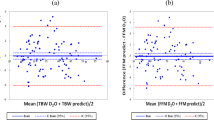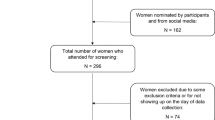Abstract
Background/objectives
Estimating body composition using bioelectric impedance analysis (BIA) requires specific prediction equations. The purpose of our study was to examine the validity of published BIA equations for assessing total body water (TBW) and fat-free mass (FFM) using deuterium oxide dilution (D2O) as a reference method and to develop new FFM and TBW BIA equations if needed for Moroccan pre-pubertal children.
Subjects/methods
Data were collected from 247 schoolchildren aged 8–11 years old. Children were sorted by gender and age group and assigned in development and validation groups. D2O dilution was used as reference method for estimating TBW and FFM. Bland and Altman test, effect size, pure error, and proportional bias were used to assess the reliability of previous published equations. Cross-validation was performed by Bland and Altman test and BIA new equations were developed by linear regression.
Results
Previously published equations were tested and showed significant bias values indicating that if used they would provide biased values of TBW and FFM. The new prediction equations developed were:
\(\mathrm{TBW}_{\mathrm{D}_{2}{\mathrm{O}}}\) (l) = 0.269 + 0.292 Ht2/R (cm2/Ω) + 0.221 weight (kg) + 0.824 sex (boys = 1, girls = 0) + 0.291 age (years) (R2 = 0.91, RMSE = 1.54 kg);
\(\mathrm{FFM}_{\mathrm{D}_{2}{\mathrm{O}}}\) (kg) = −0.450 + 0.380 Ht2/R (cm2/Ω) + 0.291 weight (kg) + 1.294 sex (boys = 1, girls = 0) + 0.446 age (years) (R2 = 0.91, RMSE = 1.97 kg).
These equations provide better values of proportional bias, agreement, and pure error than the other tested equations.
Conclusions
The new BIA prediction equations seem to be the most accurate for Moroccan pre-pubertal children.
This is a preview of subscription content, access via your institution
Access options
Subscribe to this journal
Receive 12 print issues and online access
$259.00 per year
only $21.58 per issue
Buy this article
- Purchase on Springer Link
- Instant access to full article PDF
Prices may be subject to local taxes which are calculated during checkout

Similar content being viewed by others
References
Ng M, Fleming T, Robinson M, Thomson B, Graetz N, Margono C, et al. Global, regional, and national prevalence of overweight and obesity in children and adults during 1980–2013: a systematic analysis for the Global Burden of Disease Study 2013. Lancet. 2014;384:766–81.
Mirmiran P, Sherafat-Kazemzadeh R, Jalali-Farahani S, Azizi F. Childhood obesity in the Middle East: a review. East Mediterr Health J. 2010;16:1009–17.
Ng SW, Zaghloul S, Ali HI, Harrison G, Popkin BM. The prevalence and trends of overweight, obesity and nutrition-related non-communicable diseases in the Arabian Gulf States. Obes Rev. 2011;12:1–13.
World Health Organization (WHO). Report of the Commission on Ending Childhood Obesity; Geneva, Switzerland, 2016.
Lobstein T, Jackson-Leach R. Estimated burden of paediatric obesity and co-morbidities in Europe. Part 2. Numbers of children with indicators of obesity-related disease. Int J Pediatr Obes. 2006;1:33–41.
Litwin SE. Childhood obesity and adulthood cardiovascular disease: quantifying the lifetime cumulative burden of cardiovascular risk factors. J Am Coll Cardiol. 2014;64:1588–90.
Heymsfield SB, Lohman TG, Wang Z, Going SB. Human body composition. 2nd edn. Champaign IL: Human Kinetics; 2005.
Roubennoff R, Dallal G, Wilson P. Predicting body fatness: the body mass index vs estimation by bioelectrical impedance. Am J Public Health. 1995;85:726–8.
Gallager D, Visser M, Sepulveda D, Pierson RN, Harris T, Heymsfield SB. How useful is body mass index for comparaison of body fatness across age, sex, and ethnic groups? Am J Epidemiol. 1996;143:228–39.
Freedman DS, Wang J, Maynard LM, Thornton JC, Mei Z, Pierson RN, et al. Relation of BMI to fat and fat-free mass among children and adolescents. Int J Obes. 2005;29:1–8.
Wickramasinghe VP, Cleghorn GJ, Edmiston KA, Murphy AJ, Abbott RA, Davies PSW. Validity of BMI as a measure of obesity in Australian white Caucasian and Australian Sri Lankan children. Ann Hum Biol. 2005;32:60–71.
Segal KR, Burastero S, Chun A, Coronel P, Pierson RN Jr, Wang J. Estimation of extracellular and total body water by multiple-frequency bioelectrical-impedance measurement. Am J Clin Nutr. 1991;54:26–9.
Diaz EO, Villar J, Immink M, Gonzales T. Bioimpedance or anthropometry? Eur J Clin Nutr. 1989;43:129–37.
Hamrani A, El Kari K, Mehdad S, El Hamdouchi A, El Mzibri M, Barkat A, et al. Fat free mass prediction model for Moroccan adolescents by bioelectrical impedance analysis using deuterium oxide dilution as a reference. Int J Body Compos Res. 2012;4:107–14.
Wells JCK, Fewtrell MS, Davies PSW, Williams JE, Coward WA, Cole TJ. Prediction of total body water in infants and children. Arch Dis Child. 2005;90:965–71.
Davies PSW, Gregory JW. Body water measurements in growth disorders. [Letter]. Arch Dis Child. 1991;66:1467.
Wickramasinghe VP, Lamabadusuriya SP, Cleghorn GJ, Davies PSW. Assessment of body composition in Sri Lankan children: validation of a bioelectrical impedance prediction equation. Eur J Clin Nutr. 2008;62:1170–7.
Deurenberg P, van der Kooy K, Leenen R, Weststrate JA, Seidell JC. Sex and age specific prediction formulas for estimating body composition from bioelectric impedance: a cross-validation study. Int J Obes. 1991;15:17–25.
Schaefer F, Georgi M, Zieger A, Scharer K. Usefulness of bioelectric impedance and skinfold measurement in predicting fat-free mass derived from total body potassium in children. Pediatr Res. 1994;35:617–24.
Lorenzo A, Sorge SP, Iacopino L, Andreoli A, de Luca PP, Sasso JF. Fat free mass by bioelectrical impedance vs dual energy X ray absorptiometry (DXA). Appl Radiat Isot. 1998;49:739–41.
Ruch EC, Puniani K, Valencia ME, Davies PSW, Plank LD. Estimation of body fatness from body mass index and bioelectrical impedance: comparison of New Zealand European, Maori and Pacific Island children. Eur J Clin Nutr. 2003;57:1394–401.
Lohman TG, Roche AF, Martorell R. Anthropometric standardization reference manual. Champaign, IL: Human Kinetics; 1988.
de Onis M, Onyango AW, Borghi E, Siyam A, Nishida C, Sjekman J. Development of a WHO growth reference for school-aged children and adolescents. Bull World Health Organ. 2007;85:660–7.
Tanner J, Whitehouse R. Clinical longitudinal standards for height, weight, height velocity, weight velocity, and stages of puberty. Arch Dis Child. 1976;51:170–9.
International Atomic Energy Agency. Introduction to body composition assessment using the deuterium dilution technique with analysis of saliva Q5 samples by Fourier transform infrared spectrometry. IAEA Human Health Series. No. 12. Vienna: International Atomic Energy Agency; 2010.
Aglago KE, Menchawy IE, Kari KE, Hamdouchi AE, Barkat A, Bengueddour R, et al. Development and validation of bioelectrical impedance analysis equations for predicting total body water and fat-free mass in North-African adults. Eur J Clin Nutr. 2013;67:1–6.
Schoeller DA, Van Santen E, Paterson DW, Dietz W, Jaspan J, Klein PD. Total body water measurement in humans with 18O and 2H labeled water. Am J Clin Nutr. 1980;33:2688–93.
Lohman TG. Applicability of body composition techniques and constants for children and youths. Exerc Sports Sci Rev. 1986;14:325–57.
Lohman TG. Advances in body composition assessment. Champaign, IL: Human Kinetics; 1992. pp. 65–77.
Laurson KR, Eisenmann JC, Welk GJ. Body fat percentile curves for U.S. children and adolescents. Am J Prev Med. 2011;41:S87–92.
McBride GB. A proposal for strength-of-agreement criteria for Lin’s Concordance Correlation Coefficient. NIWA Client Report: HAM 2005-062; 2005.
Bland JM, Altman DG. Applying the right statistics: analyses of measurements studies. Ultrasound Obstet Gynecol. 2003;22:85–93.
Ludbrook J. Statistical techniques for comparing measures and methods of measurement: a critical review. Clin Exp Pharmacol Physiol. 2002;29:527–36.
Cohen J. Statistical power analysis for the behavioural sciences. 2nd edn. Hillsdale, NJ: Lawrence Erlbaum Associates; 1988.
Deurenberg P, Deurenberg-Yap M. Validity of body composition methods across ethnic population groups. Acta Diabetol. 2003;40:s246–9.
Deurenberg P, Wolde-Gebriel Z, Schouten F. Validity of predicted total body water and extracellular water using multifrequency bioelectrical impedance in an ethiopian population. Ann Nutr Metab. 1995;39:234–41.
Deurenberg P, Weststrate JA, Seidell JC. Body mass index as a measure of body fatness: age-and sex-specific prediction formulas. Br J Nutr. 1991;65:105–14.
Morrison JA, Barton BA, Obarzanek E, Crawford PB, Guo SS, Schreiber GB. Racial differences in the sums of skinfolds and percentage of body fat estimated from impedance in black and white girls, 9 to 19 years of age: The National Heart, Lung, and Blood Institute Growth and Health Study. Obes Res. 2001;9:297–305.
Kyle UG, Earthman CP, Pichard C, Coss-Bu JA. Body composition during growth in children: limitations and perspectives of bioelectrical impedance analysis. Eur J Clin Nutr. 2015;69:1–8.
Liu A, Byrne NM, Kagawa M, Ma G, Kijboonchoo K, Nasreddine L, et al. Ethnic differences in body fat distribution among Asian pre-pubertal children: a cross-sectional multicenter study. BMC Publ Health. 2011;11:500, 2–7.
Siervogel RM, Demerath EW, Schubert C, Remsberg KE, Chumlea WC, Sun S, et al. Puberty and body composition. Horm Res. 2003;60:36–45.
Kyle UG, Bosaeus I, De Lorenzo AD, Deurenberg P, Elia M, Gomez JM, et al. Bioelectrical impedance analysis-part I: review of principles and methods. Clin Nutr. 2004;5:1226–43.
Kriemler S, Puder J, Zahner L, Roth R, Braun-Fahrländer C, Bedogni G. Cross-validation of bioelectrical impedance analysis for the assessment of body composition in a representative sample of children. Eur J Clin Nutr. 2009;63:619–26.
Fomon SJ, Haschke F, Zeigler EE, Nelson SE. Body composition of reference children from birth to age 10 years. Am J Clin Nutr. 1982;35:1169–75.
Deurenberg P, Kusters CSL, Smit HE. Assessment of body composition by bioelectrical impedance of children and young adults is strongly age dependant. Eur J Clin Nutr. 1990;44:261–8.
Guo SS, Chumlea WC, Cockram DB. Use of statistical methods to estimate body composition. Am J Clin Nutr. 1996;64:428S–35S.
Acknowledgements
The authors would like to gratefully acknowledge the contributions of schoolchildren who participated in this study, their parents, teachers, directors, and other support staff. This study was performed with the support of the International Atomic Energy Agency (Project RAF/06/42).
Author information
Authors and Affiliations
Corresponding author
Ethics declarations
Conflict of interest
The authors declare that they have no conflict of interest.
Rights and permissions
About this article
Cite this article
El Harchaoui, I., El Hamdouchi, A., Baddou, I. et al. Development and validation of bioelectrical impedance analysis equations for prediction total body water and fat-free mass using D2O technique in Moroccan children aged between 8 and 11 years old. Eur J Clin Nutr 72, 1663–1672 (2018). https://doi.org/10.1038/s41430-018-0093-2
Received:
Revised:
Accepted:
Published:
Issue Date:
DOI: https://doi.org/10.1038/s41430-018-0093-2



